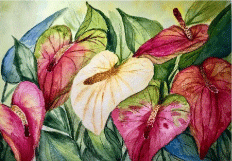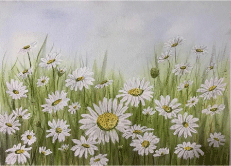Perspective
It may be difficult to imagine how art can impact the practice of medicine, but it does in so many ways. I write from my personal experience as a physician who has discovered the wonder and beauty of visual arts after several years of practicing nephrology.
Asphysicians, and this is true for most of us, we are exposed to the intricacies and challenges of patient care. It is almost always not easy, often stressful and some days may be particularly difficult. Physician burnout is real, and we try to find ways to help ourselves and our colleagues overcome this. I have never imagined that engaging myself in visual arts could help assuage the undesirable effects of burnout. I discovered art a year ago by joining watercolor workshops upon the invitation of artist physicians who conducted them to fulfill a hobby. We found a common ground, wherein we enjoyed each other’s company during the art workshops but also, we felt pleased and accomplished with our art work. I for myself discovered that the process of watercolor painting and producing a work of art was a very effective stress reliever. Painting providedme a short albeit a rare deviation from the routine and provided me with a new way of expressing myself. Picking up the brush and painting on an empty canvass actually allowed me to clear my mind and like a refresh button, allowed new ideas for managing and treating my patients to arise. It helped me deal with the anxieties of clinical practice and for me ithelped tremendously in diminishing physician burn out. Since then watercolor painting is now a daily habit, alongside the practice of medicine.
Art not only benefits physicians but more importantly patients can benefit from art. Our institution has organized several art exhibits participated in byprofessional artists and physician artists like myself. The purpose of these exhibits was to raise money for the benefit of our charity patients. By doing so, several artists were encouraged to share their work and at the same time the patient beneficiaries received much needed medical care. Artist physicians on the other hand, were encouraged to continue their passion for art andwere provided with an avenue for sharing their work. I have contributed some pieces for the “Hearts of Gold Charity Program” of our institution that were for the benefit of our cardiac surgery patients (Figure 1).

Figure 1:
Visual art can provide patients a calming feeling especially when these paintings are along the themes of landscapes and flowerfields. Having been commissioned to make a couple of paintings for a hospital room, I decided to make smaller paintings first and see how they affect patients. The paintings were floral themed and were mostly of flower fields with beautiful horizons. Upon seeing these paintings, most of the patients did say that they felt clam and peaceful(Figure 2). There is the possibility that visual arts can help patients psychologically by helping soothe their fears and anxieties. More importantly visual art that give patients hope and the will to live can help physicians as wellin the practice of medicine.Beautiful paintings can give patients the strength and encouragement to face their illness.

Figure 2:
Art can represent a patient’s progress. One of my patients, who was an amateur artist, have totally abandoned painting when he was ill from kidney failure.Being uremic, he did not have the energy nor the enthusiasm to come up with new works of art. His interest in art had disappeared.After he was initiated on hemodialysis, and he gradually felt better, it took less than a month for him to resume his hobby. He then presented me with a beautiful painting as a gift. I felt that medical care has helped this patient, such that it allowed him to do what he loves, but more importantly I also felt a sense of accomplishment as his physician.
Art can come in several ways and it can impact patient care is many ways.In our institution, we prepare giveaways for our patients on special occasions not only as a token of appreciation for their trust in us, but also to encourage patients in their journey.I have written about the way our dialysis unit have made neck pillows as a gift for patients at Christmas time and how I designed a “Flower Kidney” to be printed on these pillows.It was a watercolor of brightly colored tropical flowers shaped into a kidney. These were very well appreciated by the patients but most of all they were so proud that a physician designed the art on the pillows. The sense of gratitude for both patients and physicians were priceless. In a recent lecture I gave for a convention of cardiologists I painted a “Flower Heart” to break the ice and keep the interest of the audience, the painting was well appreciated. I am hoping to donate the design for tokens for patient giveaways for “Heart Month” in the coming February (Figure 3).

